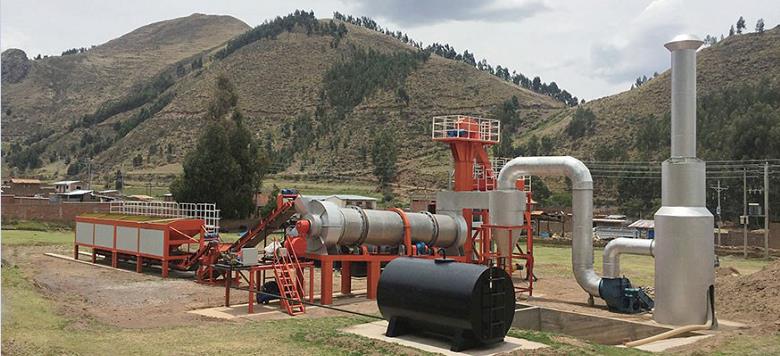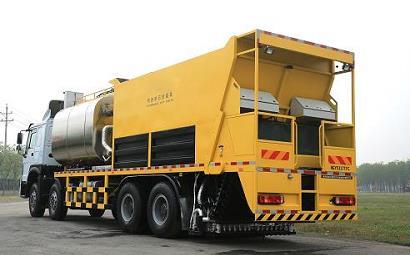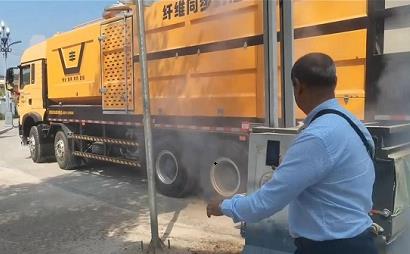The similarities & differences of drum asphalt plants and counter flow asphalt plants
Continuous drum mixing plant is a professional mixing equipment that produces asphalt mixture in continuous drum mode, this plant can be divided into asphalt drum mix plants and counter flow asphalt mixing plants. Both of these factories manufacture hot mix asphalt in a continuous operation. The aggregate heating, drying and material mixing of the two types of asphalt plants are all carried out in the drum.
Continuous drum mixing plants (drum Mix Plant and continuous mix plant) are commonly used in construction engineering, water and power, harbor, wharf, highway, railway, airport, and bridge building, among other things. It has a cold aggregate supply system, a combustion system, a drying system, a mixing system, a water dust collector, an asphalt supply system, and an electrical control system.

The similarities of drum asphalt plants and
counter flow asphalt plants
Loading cold aggregates into feed bins is the first step in the Asphalt Drum Mix Plant operation. The equipment typically has three or four bin feeders (or more), and aggregates are put into various bins based on size. This is done to grade different aggregate sizes according to the project's requirements. Each compartment has a movable gate for controlling the flow of material. Below the bins is a long conveyor belt that transports the aggregates to the scalping screen.
The screening procedure comes next. This single-deck vibrating screen removes large aggregates and keeps them from entering the drum.
The charging conveyor is critical in the asphalt plant process because it not only transports cold particles from below the screen to the drum but also weighs the aggregates. This conveyor has a load cell that constantly entertains the aggregates and gives a signal to the control panel.
The drying and mixing drum is in charge of two operations: drying and mixing. This drum constantly rotates, and aggregates are transferred from one end to another during the revolution. The heat from the burner flame is applied to the aggregates to minimize moisture content.
The drying drum burner's fuel tank stores and delivers fuel to the drum burner. Aside from that, the main component comprises asphalt storage tanks that store, heat, and pump needed asphalt to the drying drum for mixing with hot aggregates. Filler silos add optional filler and binder material to the mixer.
Pollution control technologies are essential in the process. They aid in the removal of potentially dangerous gases from the environment. The primary dust collector is a dry dust collector that works in tandem with the secondary dust collector, which can be either a bag filter or a wet dust scrubber.
The load-out conveyor collects ready hot mix asphalt from beneath the drum and transports it to the waiting vehicle or storage silo. The HMA is stored in an optional storage silo until the truck arrives.

The differences of
drum asphalt plants and counter flow asphalt plants
1. The drum is essential in the Asphalt Drum Mix Plant operation. In a parallel flow plant, the aggregates migrate away from the burner flame, whereas, in a counter flow plant, the aggregates move towards the burner flame. The heated aggregates are mixed with bitumen and minerals at the other end of the drum.
2. The aggregate flow in a parallel-flow plant is parallel to the burner flame. This also indicates that the aggregates move away from the burner flame as they travel. The flow of aggregates in the counter flow plant is contrary (opposite) to that of the burner flame, so the aggregates move towards the burner flame before being mixed with bitumen and other minerals. This appears straightforward, but it makes a significant impact in the process of both of these types of asphalt mixers and even influences the HMA quality. It is considered that the counter-flow mixer saves more gasoline and provides greater HMA than the other.
The control panel on today's equipment is modern and complex. They enable the storage of several mixed formulations based on consumer demand. The plant can be controlled from a single location via the control panel.
 Albanian
Albanian  Russian
Russian  Arabic
Arabic  Amharic
Amharic  Azerbaijani
Azerbaijani  Irish
Irish  Estonian
Estonian  Odia (Oriya)
Odia (Oriya)  Basque
Basque  Belarusian
Belarusian  Bulgarian
Bulgarian  Icelandic
Icelandic  Polish
Polish  Bosnian
Bosnian  Persian
Persian  Afrikaans
Afrikaans  Tatar
Tatar  Danish
Danish  German
German  French
French  Filipino
Filipino  Finnish
Finnish  Frisian
Frisian  Khmer
Khmer  Georgian
Georgian  Gujarati
Gujarati  Kazakh
Kazakh  Haitian Creole
Haitian Creole  Korean
Korean  Hausa
Hausa  Dutch
Dutch  Kyrgyz
Kyrgyz  Galician
Galician  Catalan
Catalan  Czech
Czech  Kannada
Kannada  Corsican
Corsican  Croatian
Croatian  Kurdish (Kurmanji)
Kurdish (Kurmanji)  Latin
Latin  Latvian
Latvian  Lao
Lao  Lithuanian
Lithuanian  Luxembourgish
Luxembourgish  Kinyarwanda
Kinyarwanda  Romanian
Romanian  Malagasy
Malagasy  Maltese
Maltese  Marathi
Marathi  Malayalam
Malayalam  Malay
Malay  Macedonian
Macedonian  Maori
Maori  Mongolian
Mongolian  Bengali
Bengali  Myanmar (Burmese)
Myanmar (Burmese)  Hmong
Hmong  Xhosa
Xhosa  Zulu
Zulu  Nepali
Nepali  Norwegian
Norwegian  Punjabi
Punjabi  Portuguese
Portuguese  Pashto
Pashto  Chichewa
Chichewa  Japanese
Japanese  Swedish
Swedish  Samoan
Samoan  Serbian
Serbian  Sesotho
Sesotho  Sinhala
Sinhala  Esperanto
Esperanto  Slovak
Slovak  Slovenian
Slovenian  Swahili
Swahili  Scots Gaelic
Scots Gaelic  Cebuano
Cebuano  Somali
Somali  Tajik
Tajik  Telugu
Telugu  Tamil
Tamil  Thai
Thai  Turkish
Turkish  Turkmen
Turkmen  Welsh
Welsh  Uyghur
Uyghur  Urdu
Urdu  Ukrainian
Ukrainian  Uzbek
Uzbek  Spanish
Spanish  Hebrew
Hebrew  Greek
Greek  Hawaiian
Hawaiian  Sindhi
Sindhi  Hungarian
Hungarian  Shona
Shona  Armenian
Armenian  Igbo
Igbo  Italian
Italian  Yiddish
Yiddish  Hindi
Hindi  Sundanese
Sundanese  Indonesian
Indonesian  Javanese
Javanese  Yoruba
Yoruba  Vietnamese
Vietnamese  Hebrew
Hebrew  Chinese (Simplified)
Chinese (Simplified)







